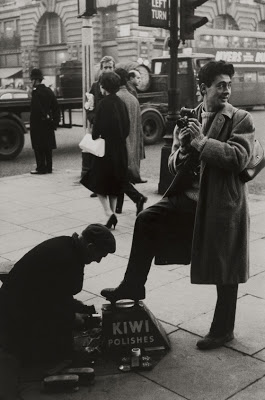Sergio Larraín por Jean Mouniq. Londres 1959
Sergio Larrain obituary
Experimental Chilean photographer whose short career resulted in a string of inspirational images
Larrain's 1963 photo Limón Soda, Valparaíso. Photograph: Sergio Larrain/Magnum
Although he was photographically active for scarcely more than a decade and was the author of just four books (all of them now collectors' items), the stature and reputation of the Chilean photographer Sergio Larrain, who has died aged 80, continued to grow after he withdrew from the vibrant European world of street photography to live in a meditational retreat.![Sergio Larrain]() Sergio Larrain in 1967. Photograph: Rene Burri/Magnum
Sergio Larrain in 1967. Photograph: Rene Burri/Magnum
Sergio Larrain obituary
Experimental Chilean photographer whose short career resulted in a string of inspirational images
Amanda Hopkinson The Guardian Friday 24 February 2012 14.14 GMT
Although he was photographically active for scarcely more than a decade and was the author of just four books (all of them now collectors' items), the stature and reputation of the Chilean photographer Sergio Larrain, who has died aged 80, continued to grow after he withdrew from the vibrant European world of street photography to live in a meditational retreat.
 Sergio Larrain in 1967. Photograph: Rene Burri/Magnum
Sergio Larrain in 1967. Photograph: Rene Burri/MagnumBorn into a professional family in Santiago (his father was an architect), he began by studying music. At the age of 18, he went to the US and studied forestry at the University of California, Berkeley, before transferring to Ann Arbor, Michigan, in 1954. He also travelled through Europe and the Middle East, taking a camera. When he returned home, he began freelancing for the Brazilian magazine O Cruzeiro with a heart-searing series on street children living on the banks of the Rio Mapuche. The Museum of Modern Art in New York acquired two images for its collection in 1956.
In 1958 Larrain obtained a grant from the British Council to undertake an eight-month reportage project on British cities. The book that resulted focused on London, with the swinging 60s just around the corner, capturing the ebb and flow of crowds on the streets and transport system. The work so impressed Henri Cartier-Bresson that he invited Larrain to join the Magnum agency that he had co-founded in 1948, with "Chim" Seymour, George Rodger and Robert Capa.
Larrain joined as an associate in 1959 and was set a mission impossible: to photograph the mafia boss Giuseppe Russo, wanted for multiple murder by Interpol. Larrain took the task seriously and spent months researching and photographing from Rome to Sicily, where he finally located Russo in Caltanissetta. He then spent a fortnight winning the trust of Russo's bodyguards before passing off his 35mm Leica as an artistic tourist's toy. The pictures of Russo were published in Life in the US and Paris Match in France, before being syndicated globally. In 1961 Larrain became a full member of the world's most famous photographic agency.
In 1963 he published El Rectángulo en la Mano(Rectangle in Hand). In 1966 Una Casa en la Arena (A House in the Sand) appeared, about Pablo Neruda's house on Isla Negra, with a text by the poet. Neruda also supplied the text for perhaps Larrain's most famous book, Valparaiso (1991), containing a striking image of two little girls running down a flight of stone steps, their white frocks and rectangular bobbed haircuts a microcosm of the stark geometry of black shadows and noonday sun.
Larrain recalled taking it "in a state of peace and utter serenity, just pursuing what at the time interested me most. Then, as if from nowhere, first one little girl appeared, shortly joined by another. It was more than perfect, it was a magical image." Agnes Sire, for 20 years desk editor of Magnum (Paris), described it as taken in "not so much a decisive moment as in the state of spirit that he called a state of grace".
Larrain was endlessly experimental. One afternoon in the 1950s, he was taking photographs outside Notre Dame in Paris and captured scenes between a couple which he only noticed when he developed the film. This provided the inspiration for Julio Cortázar's extraordinary 1959 story The Devil's Drool, which in turn was the basis for Michelangelo Antonioni's 1966 film Blow-Up.
In 1968 Editions Rencontre published Chile, in which all but two of the pictures are Larrain's. It is the only book to use his work as illustration, rather than art. The rest of the books issued under his name, published throughout the 1990s primarily as exhibition catalogues, are reprises or re-edits of earlier ones. In 1999 the Valencia Institute of Modern Art held a Larrain retrospective which led to a huge resurgence of interest. This was something Larrain loathed, for by then he had chosen to find his state of grace through meditation.
In 1972 he had met the Bolivian mystic Oscar Ichazo and abandoned photography to study oriental religions, calligraphy and painting, and to practise and teach yoga. First at Ovalle, then moving still further and higher into the mountains to Tulahuén, Larrain led an increasingly isolated life – except in one sense. He became a copious letter-writer. John Morris, the former Magnum bureau chief, described his letters as "all ruminations on the sad state of the world and appeals to me to take action to improve it".
Larrain is survived by a son and daughter.
• Sergio Larrain, photographer, born 5 November 1931; died 7 February 2012
• This article was amended on 6 March. The first caption had said that the photograph was taken in Paris, and Larrain's date of death was given as 10 February. These points have been corrected.




